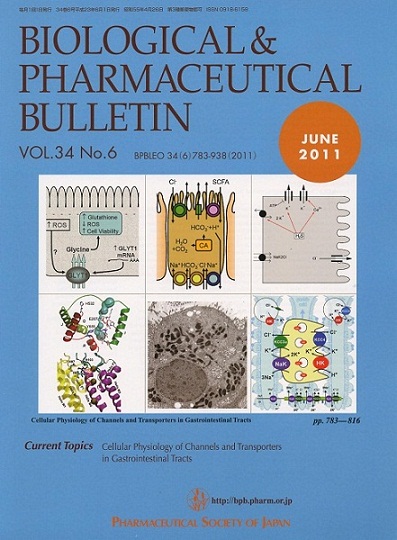34 巻, 6 号
選択された号の論文の30件中1~30を表示しています
- |<
- <
- 1
- >
- >|
Current Topics
-
原稿種別: Current Topics
2011 年 34 巻 6 号 p. 783
発行日: 2011/06/01
公開日: 2011/06/01
PDF形式でダウンロード (394K) -
原稿種別: Current Topics
2011 年 34 巻 6 号 p. 784-788
発行日: 2011/06/01
公開日: 2011/06/01
PDF形式でダウンロード (2734K) -
原稿種別: Current Topics
2011 年 34 巻 6 号 p. 789-793
発行日: 2011/06/01
公開日: 2011/06/01
PDF形式でダウンロード (1051K) -
原稿種別: Current Topics
2011 年 34 巻 6 号 p. 794-802
発行日: 2011/06/01
公開日: 2011/06/01
PDF形式でダウンロード (1138K) -
原稿種別: Current Topics
2011 年 34 巻 6 号 p. 803-809
発行日: 2011/06/01
公開日: 2011/06/01
PDF形式でダウンロード (2353K) -
原稿種別: Current Topics
2011 年 34 巻 6 号 p. 810-812
発行日: 2011/06/01
公開日: 2011/06/01
PDF形式でダウンロード (2614K) -
原稿種別: Current Topics
2011 年 34 巻 6 号 p. 813-816
発行日: 2011/06/01
公開日: 2011/06/01
PDF形式でダウンロード (5260K)
Regular Articles
-
原稿種別: Regular Article
2011 年 34 巻 6 号 p. 817-823
発行日: 2011/06/01
公開日: 2011/06/01
PDF形式でダウンロード (1028K) -
原稿種別: Regular Article
2011 年 34 巻 6 号 p. 824-830
発行日: 2011/06/01
公開日: 2011/06/01
PDF形式でダウンロード (7072K) -
原稿種別: Regular Article
2011 年 34 巻 6 号 p. 831-838
発行日: 2011/06/01
公開日: 2011/06/01
PDF形式でダウンロード (2475K) -
原稿種別: Regular Article
2011 年 34 巻 6 号 p. 839-844
発行日: 2011/06/01
公開日: 2011/06/01
PDF形式でダウンロード (2506K) -
原稿種別: Regular Article
2011 年 34 巻 6 号 p. 845-849
発行日: 2011/06/01
公開日: 2011/06/01
PDF形式でダウンロード (1643K) -
原稿種別: Regular Article
2011 年 34 巻 6 号 p. 850-855
発行日: 2011/06/01
公開日: 2011/06/01
PDF形式でダウンロード (1208K) -
原稿種別: Regular Article
2011 年 34 巻 6 号 p. 856-864
発行日: 2011/06/01
公開日: 2011/06/01
PDF形式でダウンロード (844K) -
原稿種別: Regular Article
2011 年 34 巻 6 号 p. 865-870
発行日: 2011/06/01
公開日: 2011/06/01
PDF形式でダウンロード (1493K) -
原稿種別: Regular Article
2011 年 34 巻 6 号 p. 871-876
発行日: 2011/06/01
公開日: 2011/06/01
PDF形式でダウンロード (1080K) -
Development and Validation of an LC/MS/MS Method for the Determination of Tenofovir in Monkey Plasma原稿種別: Regular Article
2011 年 34 巻 6 号 p. 877-882
発行日: 2011/06/01
公開日: 2011/06/01
PDF形式でダウンロード (620K) -
原稿種別: Regular Article
2011 年 34 巻 6 号 p. 883-889
発行日: 2011/06/01
公開日: 2011/06/01
PDF形式でダウンロード (696K)
Notes
-
原稿種別: Note
2011 年 34 巻 6 号 p. 890-893
発行日: 2011/06/01
公開日: 2011/06/01
PDF形式でダウンロード (755K) -
原稿種別: Note
2011 年 34 巻 6 号 p. 894-897
発行日: 2011/06/01
公開日: 2011/06/01
PDF形式でダウンロード (1810K) -
原稿種別: Note
2011 年 34 巻 6 号 p. 898-900
発行日: 2011/06/01
公開日: 2011/06/01
PDF形式でダウンロード (544K) -
原稿種別: Note
2011 年 34 巻 6 号 p. 901-905
発行日: 2011/06/01
公開日: 2011/06/01
PDF形式でダウンロード (6340K) -
原稿種別: Note
2011 年 34 巻 6 号 p. 906-911
発行日: 2011/06/01
公開日: 2011/06/01
PDF形式でダウンロード (896K) -
原稿種別: Note
2011 年 34 巻 6 号 p. 912-916
発行日: 2011/06/01
公開日: 2011/06/01
PDF形式でダウンロード (1323K) -
原稿種別: Note
2011 年 34 巻 6 号 p. 917-920
発行日: 2011/06/01
公開日: 2011/06/01
PDF形式でダウンロード (488K) -
原稿種別: Note
2011 年 34 巻 6 号 p. 921-924
発行日: 2011/06/01
公開日: 2011/06/01
PDF形式でダウンロード (842K) -
原稿種別: Note
2011 年 34 巻 6 号 p. 925-928
発行日: 2011/06/01
公開日: 2011/06/01
PDF形式でダウンロード (832K) -
原稿種別: Note
2011 年 34 巻 6 号 p. 929-932
発行日: 2011/06/01
公開日: 2011/06/01
PDF形式でダウンロード (911K)
Communication to the Editor
-
原稿種別: Communication to the Editor
2011 年 34 巻 6 号 p. 933-936
発行日: 2011/06/01
公開日: 2011/06/01
PDF形式でダウンロード (2583K)
Errata
-
原稿種別: Errata
2011 年 34 巻 6 号 p. 937
発行日: 2011/06/01
公開日: 2011/06/01
PDF形式でダウンロード (379K)
- |<
- <
- 1
- >
- >|
